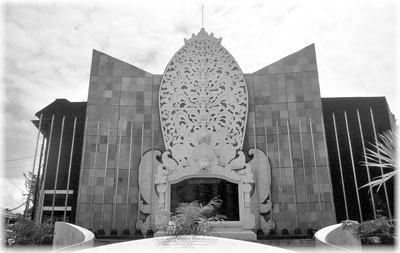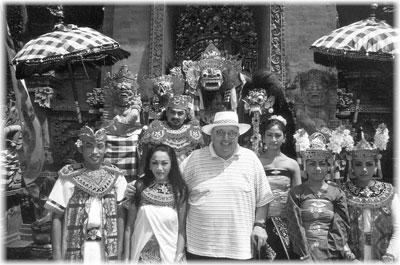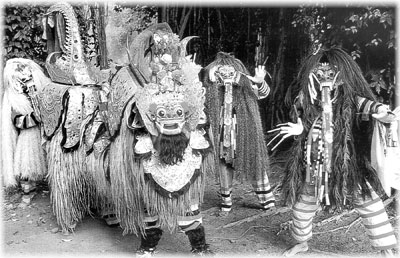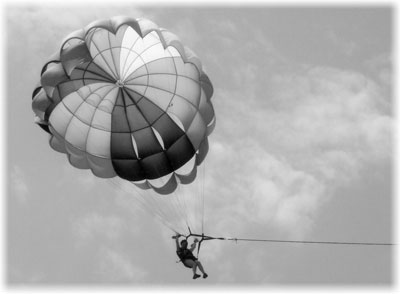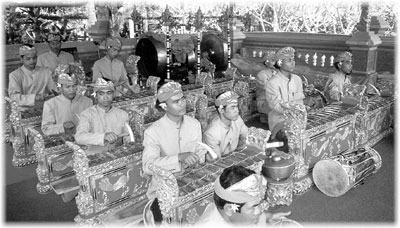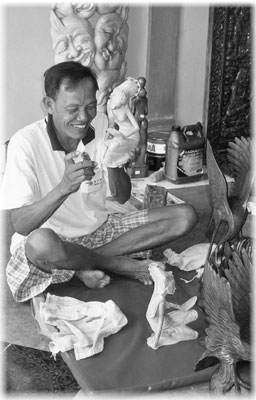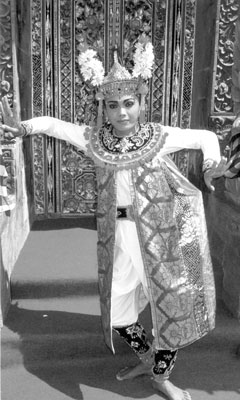Beautiful Bali — an unbelievable bargain
by Harold Grady, St. Louis, MO
From the plane, I could see, appearing like tiny specks, some of the 17,508 islands of Indonesia that straddle the equator between Southeast Asia and Australia. As we flew through the clouds and circled the beautiful island of Bali, it was love at first sight.
Planning the trip
The idea for this tropical-island trip occurred to me eight months earlier on a cold, snowy day back home in St. Louis, Missouri. I had heard that Bali, recovering from the 2002 terrorist bombings, was one of the best travel bargains in the world.
So my wife, Donna, and I studied brochures, travel books and videotapes from the library. We wanted a tour that would be inexpensive and fun, with an emphasis on Bali’s culture and folklore.
We chose a first-class 14-day tour that included 4- and 5-star luxury hotels, breakfast daily and round-trip air from San Francisco for the affordable price of $1,099 from Sayang Holidays (220 Montgomery St., Ste. 469, San Francisco, CA 94104; 888/472-9264, www.sayangholidays.com). Additionally, it cost $300 for a St. Louis add-on airfare and $150 in airport taxes.
Our thirst for adventure included an elephant safari, river rafting, parasailing, sunset cruises, beach sports and treks into bird and orchid parks. Even better were the optional on-island tours ($20 for a 4-hour tour) scheduled every other day to visit temples, villages, volcanoes, Komodo dragons, alligators and other wildlife. It sounded like the perfect itinerary to me because we could tailor it to our own interests and passions on a pay-as-you-go basis.
Bali is hot and humid all year, but, to avoid the rainy season from October to March, the best time to go is from May to September (which is also the time of lowest humidity, 60%). We selected Sept. 6-19, ’05, to avoid the peak tourist season prices.
We enjoy traveling with friends, so we invited fellow members of the International Travel Club of St. Louis (contact the president, Harold Grady, 2039 Silent Spring Dr., St. Louis, MO 63043; phone 314/275-8445) to join us. Donna and I were excited when 15 friends signed up to go.
In preparation for the trip, our travel club arranged lectures and videotape presentations on Bali as well as a demonstration of packing light for the tropics. Armed with passports, high hopes and Tootsie Rolls, we were ready for Bali.
Getting there
As travel junkies, my wife and I travel light, usually with just one carry-on bag each. Singapore Airlines offered a great stopover program in Singapore en route to Bali, with a hotel and a choice of seven tours ($40), that I strongly recommend. After 22 hours on an airplane from St. Louis, it was a welcome relief to stop over in Singapore, get some sleep to shake off the jet lag, take a city tour, then continue on refreshed and ready to go.
Upon arrival at the Bali airport, we paid $25 for a visa. In exchanging money at the airport, I was startled to receive 10,130 rupiahs for $1. I cashed $100 and felt like a millionaire with over one million rupiahs stuffed in my pockets.
We were greeted at the airport with fragrant frangipani flowers and hugs of welcome. Our guide gathered up the 17 members of our group, along with our baggage, and escorted us to our hotel for a refreshing fruit drink.
The Parigata Resort & Spa (Jalan Danau Temblingan 87; phone +62 361 286 286, www.parigatahotels bali.com), our hotel in Sanur, was in a prosperous, upscale beach community. It had 45 air-conditioned rooms ($115 double) and 18 villas finished in teak and marble, with terraces overlooking the pool and waterfall, plus tropical gardens, beautiful bougainvillea flowers and a restaurant, massage center, well-stocked gift shop and drugstore.
An introduction
The next morning, Donna and I played on the beach. We sat in two bamboo chairs and listened to the breakers gently pounding the white sands of Sanur Bay. The cooling breezes blowing in off the Indian Ocean made me want to sleep 12 hours a day. Instead, after collecting a few shells, we strolled into town, where the local people were friendly and quick to smile, even at strangers.
A Bali orientation was held at our hotel to give us an insight into local customs and provide information on Indonesia and itinerary suggestions. During the orientation, we were cautioned to avoid the hot midday sun by shopping or touring in early morning or late afternoon. We were discouraged from driving, as traffic was congested and undisciplined and road conditions were bad, and we were warned to be careful where we walked to avoid holes in the sidewalks or streets.
A captivating performance
We met our guide, Widi Rantawan, a 54-year-old native of Bali with excellent knowledge of English and 15 years of experience as a travel guide. Everybody fell in love with Widi, who was witty and entertaining and had a keen sense of humor. He was not only an excellent guide, he was our interpreter, bodyguard and troubleshooter, with high-octane energy.
Widi took our group to an absolutely must-see attraction, the Uluwatu Temple at sunset. This 4-hour tour included a ride through the tropical countryside to the majestic temple perched on a 250-foot-tall sheer cliff to witness an unforgettable Kecak dance performance ($25 with dinner).
It was a spine-tingling performance, with flickering torches casting an eerie light at the edge of the cliff. The Kecak dance featured a male chorus of 70 bare-chested warriors who created a living circular stage around the female temple dancers. They chanted while the female dancers, dressed in glittering gold sarongs and tiaras, performed with swaying movements the epic Ramayana, a classic Hindu poem of good versus evil. Don’t miss it!
Driving through the countryside, we found a Bali so picturesque you could be fooled into thinking it was a painted backdrop. Rice paddies tripped down hillsides like giant steps, the tropical rainforests were lush, volcanoes soared through the clouds, wild orchids were everywhere, and the beaches were lapped by the warm waters of the Indian Ocean.
Sanur sights
While Donna and I relaxed at the pool the next day, most of our fellow travelers were lavish in their praise of a full-day tour ($50) to the 17th-century Ulun Danu Temple on the shore of the mystical Lake Bratan. It ended with a spectacular sunset at the famous Tanah Lot Temple, a pagoda-like temple that sits on an offshore rock and was listed as the most photographed temple in Asia. Legend has it that when the tide goes out, sacred snakes come out to guard the temple.
Sanur was crowded with high-priced luxury hotels and bungalows hugging the shoreline. The town has an art museum, three discos, a bowling alley, one golf course, cocktail lounges, many restaurants and lots of older tourists.
One of our most exciting experiences in Sanur was renting a brightly painted motorized outrigger, with a big eye painted on the boat’s prow to ward off evil demons or serpents, and sailing around the lagoon ($15). You can even dive down 10 feet to the USS Liberty, a ship sunk during World War II by a Japanese torpedo.
As a retired Army colonel, I was fascinated to learn that the beach at Sanur was the main target for invasion by foreign armies, including the Dutch Army, the Japanese Army and, in 2004, an army of 1_ million tourists.
A remarkable recovery
Most travelers stay in either Kuta or Sanur. I was particularly interested in Bali’s recovery efforts following the 2002 terrorist bombings in Kuta that killed 202 people, as well as the tourist trade. The explosions destroyed Paddy’s Bar, a popular nightclub, and the Sari Club.
A permanent memorial building listing victims’ names has been built at Ground Zero in Kuta. We drove by and examined the blast sites, discovering that Paddy’s Bar had been rebuilt. The Sari Club site was a vacant lot littered with weeds and rubble, but a large commemorative banner offered prayers of love and peace to all the victims of terror.
Bali had made a remarkable recovery. Business was booming along its four miles of crowded pubs, boutiques, gift shops and nonstop night spots. The tourists were back, claiming Kuta had great beaches, a fantastic sunset, good shopping and world-class surfing. Government reforms put a tighter leash on newcomers and security, but the question remained, was it enough?*
I couldn’t believe how cheap the prices were in Bali, where the average wage is only $150 a month. For example, cigarettes were 50¢ a package, gasoline was 60¢ a gallon, and hiring a car and driver cost $55 a day. Haircuts were only 50¢.
As an example of tourist prices in our hotel restaurant, a dinner of steak Bolognaise smothered in onions, rice and vegetables cost $1.90. My wife and I had dinner and beverages for two for only $5.90. A fruit platter or banana split was 90¢. Unbelievable!
Denpasar
After three nights in Sanur, our St. Louis group hopped on a bus heading 55 miles up-country to Ubud by way of Denpasar, the island’s capital city. With a half million people, Denpasar is the largest and busiest city in Bali, crammed with cars, noisome bemo vehicles, roaring motorcycles and smelly, spewing buses. The main sights here are the Bali Museum (a “must see”), Puputan Square, government buildings and markets.
The most heartwarming experience of our trip was in Denpasar at the Dharma Jati II Orphanage, which provides care and training for 226 children between the ages of five and 16. As we stepped off the bus, our group was met by several teachers and 25 excited orphans. The children greeted us, shook our hands and escorted us into the orphanage. They then performed Balinese songs, singing their way into our hearts.
To reciprocate, our St. Louis group sang “Row, Row, Row Your Boat” and “Happy Birthday,” which surprised and delighted the children. After the kids lined up for gifts, we got acquainted. They escorted us individually through the building to see their bedrooms, kitchen, laundry and facilities. While conditions were less than desirable in some cases, the children looked clean, well cared for and happy.
As our bus pulled away, I looked out the rear window, and I will never forget the image of the children waving good-bye to us.
On to Ubud
On our way to Ubud, the bus passed villages whose names rolled off the tongue: Sanur, Kuta, Denpasar, Batubulan, Celuk and Mas. As we neared our destination at noon, the sense of excitement was contagious. We arrived at the Bali Mini Center in Ubud, entering through a magnificent palace to a temple courtyard for lunch, music and a traditional dance performance. Stretching my imagination, it was easy to see myself on the throne surrounded by servants and a harem of dancing girls dressed in silks and jewels.
As we ate and listened to the traditional gamelan orchestra, it was hard to believe the music had been passed down from generation to generation purely by memory. A dozen musicians dressed in gold tunics and red headbands struck gongs, keys and drums, using cymbals and flutes in a melody that filled the temple courtyard with a faintly echoing sound.
The show opened with the Barong Dance, involving an eternal fight between good and evil spirits. Of course, good always trumps evil, in this case with the help of a clown, a chattering monkey and the god Sahadewa.
When the temple doors opened for the next play, two beautiful girls came through, slowly descending the steps onto the courtyard. Their costumes were spectacular, wrapping the girls from head to toe in hand-painted gold brocade that glittered in the sun. They wore shining, gold-mirrored headdresses topped with frangipani flowers that glided and swayed with each graceful movement. They seemed like little statues, intricate and delicate, that had come to life to perform the classic Legong dance for us.
Perhaps the most exquisite and popular of Balinese dances, the Legong portrays the story of unrequited love and war. While I couldn’t understand everything, the dancers, costumes and choreography were overwhelmingly beautiful, particularly in this temple setting. It was unforgettable and should not be missed.
Resort living
In Ubud, we checked into the Sahadewa Resort & Spa (Jl. Hanoman; www.sahadewaresort.com) for the next seven nights. The Sahadewa was artistically built in the Balinese style, with 24 rooms ($75 double), a swimming pool, restaurant and free shuttle transportation.
Our room next to the pool had a queen-size canopy bed, a shower, an 8-foot-long bathtub that took 50 minutes to fill, a unique remote-controlled air-conditioner, TV, coffee maker and a well-stocked refrigerator filled with snacks and free bottled water.
The resort was across the street from rice paddies yet ideally located in the center of Ubud within walking distance of the museum, shopping, the palace, restaurants and the Monkey Forest.
The first thing I did was to arrange for a one-hour Balinese massage ($7.50), which included skin rolling, long kneading strokes, acupressure and a foot massage. For another five dollars, you get all the trimmings, including sandalwood oil, a body scrub and a warm herbal bath with scented flowers.
Ubud is the cultural capital of Bali, with 6,000 inhabitants spilling over into the adjoining villages of Peliatan, Campuhan and Pengoseken. There is probably no place on Earth with as many accomplished dancers, musicians, artists and woodcarvers. Ubud’s main sights include the Puri Saren Palace, the Museum Puri Lukisan, the Agung Rai Museum of Art (ARMA), numerous temples, the central market and the Monkey Forest, not to mention hundreds of art galleries, studios, souvenir shops and tourists looking for bargains.
People love to shop in Ubud, especially at prices cheaper than those in Kuta. Plan to shop in the evenings, when it’s cooler.
The central market was bursting at the seams with batik clothing, woodcarvings, basketry, paintings, dangling earrings and junk jewelry along with toy gamelan sets, fans and handicrafts. You’re expected to bargain, but it was easy to go broke saving money.
Arranging excursions
In Ubud, temple festivals, celebrations and performing arts were offered every day. Check with your hotel or the tourist bureau for schedules which include unusual events such as cremations and teeth-filing ceremonies.
The best places for people-watching were Ubud’s central market and the Monkey Forest when tourists are feeding the monkeys.
A note of warning about the monkeys at Monkey Forest — protect your valuables and cameras. One of our members had her glasses snatched off her face by a mischievous monkey. She chased him but never recovered her glasses. Remove your jewelry and be wary of aggressive monkeys.
We were told not to smile or bare our teeth, which is a sign of hostility to monkeys. If you don’t carry food, the monkeys should leave you alone.
Independent travelers can book inexpensive daily coach tours at the Ubud Tourist Office (Jl. Raya Ubud, 80571; phone 0361 973 285), which listed eight tours daily. None of the tours cost more than $10, but they did not include any entrance fees or lunch; for example, the “Kintamani Volcano Tour” price was $7.50. Or you can hire a car, driver and guide for $50 a day; sharing the costs between two couples lowers your cost to an affordable $12.50 each.
Our fellow members scattered to the winds in Ubud, following their whims and passions. Some went parasailing or on an elephant safari while others played with Komodo dragons or chased butterflies around Ubud on a motor scooter. Some gave high praise to the Bali Bird Park and the Bali Orchid Garden. Everyone was eager to meet the people, taste the food and peek into the culture.
Into the mountains
One of the most interesting tours was our tour to Kintamani, about 55 miles north of Ubud, to see Mt. Batur and Mt. Agung. Mt. Agung is the most sacred mountain in Bali, followed by Mt. Batur, where the gods are said to reside. The mountains are also the source of life for the Balinese, as they produce lakes and rivers, sustaining the land’s fertility.
Conversely, both mountains, being live volcanoes, are also a source of death and destruction. Mt. Agung erupted in 1963, killing over a thousand people and destroying many villages. Mt. Batur erupted in 1917, killing 1,372 people and destroying 65,000 homes.
Our spirits soared as the bus climbed higher into the hills to cooler weather. We could see rainforests, palm trees, bamboo and beautiful flowering shrubs such as frangipani, poinsettia, bougainvillea and wild orchids.
The bus rolled into the outskirts of Kintamani to the Batur Gardens Restaurant, where we grazed the buffet of chicken, beef, rice and vegetables, eating on the top deck overlooking Mt. Batur with its crater lake — a breathtaking vista.
We finished lunch and had to make a mad dash from the restaurant, past aggressive street hawkers who chased us for 50 yards to our bus. I followed closely behind our guide, who parted the crowd of hawkers like Moses parting the Red Sea, and we laughed at some of our slower friends who were held hostage until they bought something.
The scenery and landscape was astonishing as we descended from the hills. On both sides of the road, terraced rice paddies shimmered in the sunlight, many of them worked by both men and women waist deep in water and mud.
Before entering the 17th-century holy temple Pura Gunung Kawi, at Sebatu, each of the men had to put on a sarong (like a skirt). In true Indiana Jones style, we tramped along the edge of the jungle into the Hindu temple.
We entered through a candi bentar (split gate), symbolic of the splitting of the material world, allowing the physical body to enter the spirit world. On both sides of the rising steps were scary sculpted guardians to protect the temple and scare away demons.
Inside the 500-year-old temple, we stood and gawked at the ancient walls and the stone throne of Surya, the Hindu sun god. The temple seemed like a lost world with holy spirits whispering their secrets. There was something surreal about this place, like a fairy tale where the laws of time and motion do not apply.
Around Ubud
The next day, most of our fellow road warriors went on a tour to the Bali Bird and Rimba Reptile parks in nearby Gianyar ($20). Bali boasts 300 bird species and 450 wild orchid species. “This was a flower- and bird-lover’s paradise,” said Cheryl Sparks. “We even saw some Komodo dragons.”
While one part of our group went on an elephant safari, Donna and I wanted to explore the countryside for village life. Our driver kicked off his sandals in the car and curled his toes around the gas pedal. As we headed north, each mile past Ubud seemed to take us farther from the 21st century.
The road twisted around centuries of history, and we had a near collision with a villager who was herding a flock of quacking ducks in the middle of the road.
As we entered the village, signs of modern life were few. Mud walls enclosed the village temples as well as family compounds of buildings made from bamboo with thatch roofs covering open platforms and earth floors.
One eyebrow-raising sight was the layout of the village. The locals were superstitious, and its streets and barrier walls were a maze designed to obstruct evil spirits.
Every village had three temples: a village temple that faced the mountains where the gods rule, a community temple and a temple of the dead which always faced the sea, where evil spirits are believed to reside. Each family had its own family temple as well, to honor their ancestors. Our guide said there are more than 20,000 temples in Bali.
Back in Ubud, I could not get my fill of Balinese dancing. Donna and I were whisked off to the Ubud Palace for an evening performance of traditional dancing ($5 each). Performances were put on every night from 7:30 to 9, and they were outstanding. We went back twice. The free hotel shuttle dropped us off and picked us up after the show. I highly recommend it.
If you would like to see the children practicing dance, go to the Puri Saren on Jalan Raya in Ubud on Sunday or Tuesday afternoon at 3:00. It’s free, fun and fascinating to see the little girls, some only five or six years old, work so hard to learn dance movements and hand gestures.
A final farewell
Since the tour included a group farewell dinner on our last evening in Bali, we celebrated it at the 5-star Alila Ubud hotel. All 17 of my fellow carnivores ate 2-inch-thick, delicious steaks with Neanderthal gusto. The 3-course dinner was topped off with chocolate mud cake with vanilla ice cream and orange segments. We dined, danced, and applauded loudly when the 5-piece band played “Bali Hai” for us.
At dinner, I wanted to try arak, an alcoholic drink listed as a local brew distilled from rice, similar to rum. People warned me about arak, but I couldn’t leave Bali without tasting it just once. I tried it and — Wow! — it was so strong, one drink would make a jackrabbit slap a wildcat.
Back at Suhadewa Resort, we packed our bags with many wonderful memories of Bali, especially of the children at the orphanage, the fantastic Balinese dancing and the warm hospitality of the Balinese people. What I had heard about Bali was all true: friendly people, breathtaking sunrises over gorgeous beaches, tropical scenery, magnificent arts and crafts, and majestic mountains where legends and gods reign.
It must be love, because I forgive the traffic, heat and pollution. I forgive the debris and holes in the streets and sidewalks. I even forgive that monkey who steals glasses and earrings.
The next morning at the airport, we hated to say good-bye to our Balinese friends. We made many new friends, not only with the Balinese but with our fellow travel club members.
After the hugs, tears and kisses, our group split up so that 10 members could take a post-tour fling to Bangkok ($359) for four days, while the rest of us returned home.
A week later, we all caught up together at a lakeside picnic sponsored by our travel club to compare notes and exchange photos with the Bangkok group. In sharing moments and experiences like Bali and Bangkok, we became even better acquainted and strengthened our bonds of friendship.
Safety tips
We all felt safe in Bali, as violent crime is rare. However, be careful of holes in the sidewalk — one of our group fell into a hole, injuring his leg. Always carry a flashlight with you at night for safety. You’ll also need sunscreen, a hat and good walking shoes.
Also, the traffic in downtown Ubud was chaotic and dangerous. My wife and I were crossing the street (Jalan Raya Ubud) to Ary’s Warung, a popular restaurant, when I had a narrow escape. I jumped out of the way of a woman riding a motor scooter and almost collided with a taxi.
Incidentally, I can recommend Ary’s Warung (phone +62 361 975053; www.dekco.com) for the best chocolate cake in town. It was filled with hot fudge and vanilla ice cream ($5). Even better, don’t miss a visit to the toilet to see the colorful fish pond straddling the urinal — it’s one of a kind.
* Note: one week after our return, on Oct. 1, 2005, suicide bombers hit three restaurants in South Bali, killing 23 people, including three bombers, and wounding 100. The U.S. State Department currently has a travel warning (issued on Nov. 18, 2005) advising against nonessential travel to Indonesia.


